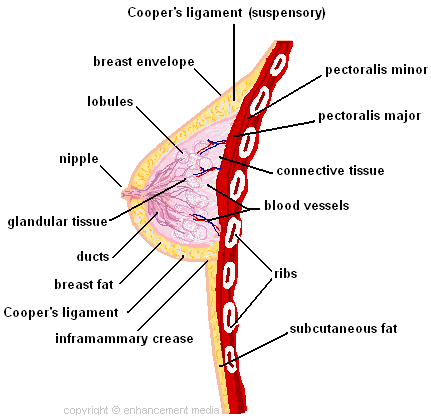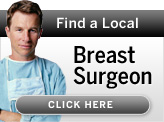Breast Anatomy and Structure
Before we start discussing potential changes to your breasts, let's get a better understanding of them, what they're made of and what influences them over their lifetime. While most women are well aware of how their breasts look on the outside, they may be a little fuzzy about what goes on inside.
Prevailing societal views aside, the primary function of breasts is not as a sex object. Breasts, at their most basic level, are organs of lactation designed to produce and deliver milk to infants and small children.
Interestingly enough, males and females begin with structurally identical breast tissue; the difference is in the way it develops as they head into adulthood. Breasts begin as a thickening ridge of tissue in the developing embryo about 6 weeks after conception. This so-called milk ridge runs from the armpits to the groin and is unrecognizable as breasts at this early stage of development.
Subcomponents of the breast become more defined during weeks 12 through 16. Groupings of cells begin to branch out, laying the foundation for milk-producing structures called mammary glands (mammae), or lobules, which are grouped in lobes and connected by ducts. This system of milk glands and ducts resembles several bunches of grapes, where the glands are the grapes and the ducts are the stems. Other tissues develop into muscle cells to form the nipple and areola (darkened tissue around the nipple), known together as the areolar complex.
By the final trimester of pregnancy, maternal hormones cross the placenta into the fetus and jump start the lobules into producing colostrum, a clear-to-yellow milky substance. Mothers will produce the same protein- and carbohydrate-rich colostrum ("first milk") in the days immediately following delivery. In a nursing mother, colostrum is the newborn's first nourishment and source of antibodies and nutrients.
From infancy until puberty, there is no discernible difference between boys' and girls' breasts. With the first onrush of estrogen and then progesterone, however, girls start to develop womanly breasts as the first phase of the sexual maturation process. The breasts enlarge and develop over 3 to 4 years, with menstruation beginning within 2 years of their growth.
Breasts reach adult size during the late teens or early twenties. Composed primarily of glandular tissue with generally only a small percentage of fat, the breasts of younger women are firmer than those of their older sisters and mothers. The softer the breasts are, the more fat they contain. Breast changes occur over a woman's lifetime, usually related to her use of synthetic hormones (as in birth control pills or hormonal therapy), a fluctuation in natural hormones (as occurs during pregnancy and breastfeeding), or the use of some herbal remedies (including wild yam, used to treat menstrual problems, infertility and menopause). As women age, particularly after the loss of estrogen at menopause, their lobes involute (shrivel) and are replaced by fat. Their breasts become softer and lose their support. In post-menopausal women who are not on supplemental estrogen therapy, body weight becomes a significant factor in the size and appearance of their breasts.
The mature female breast breaks down into four basic components: lobules, or mammary glands; milk ducts; fat and connective tissue. On average there are 15 to 20 lobes in each breast arranged around the areolar complex. When a woman is lactating, the lobes discharge the milk into the ducts, which carry it to the nipple and the waiting child.
Female hormones influence all components of the breast, but glandular tissue is the most sensitive. It undergoes very dramatic and totally normal changes in consistency during the menstrual cycle. There is a concentration of glandular tissue in the upper outer portion of the breast, which explains why many women experience tenderness in this area when their estrogen and progesterone levels peak just prior to their period. While the consistency of breast lobes vary from woman to woman, in general they have a firm, slightly nodular feel. They are surrounded by softer breast fat. This difference in density between glandular breast tissue and breast fat is the basis for mammographic imaging.
The illustration below shows the various structures that make up the chest and breast, including the lobules, milk ducts, fatty tissue (adipose), connective and glandular tissue, the nipple/areola complex, underlying pectoral muscle and the ribs.

Cooper's Ligament: a strong band of connective tissue that attaches the mammary gland to the overlying skin.
Pectoralis major: known as "pecs", it is the largest muscle of the chest. It arises from the clavicle, sternum, most or all of the ribs, and the external oblique muscle and is inserted into the humerus bone of the upper arm. It flexes to pull the arm forward.
Pectoralis minor: a smaller chest muscle that lies beneath the pectoralis major, it arises from the third, fourth, and fifth ribs and inserts into the process of the shoulder blade, stabilizing it.
Connective tissue
Blood vessels
Ribs
Subcutaneous fat: fat just beneath the skin
Inframammary crease: the fold or crease under the breast where the breast lobe meets the torso.
Breast fat: fatty tissue found above the glandular tissue of the breast.
Ducts: any tube that carries a glandular secretion. In the breast, they're called lactiferous ducts, or milk ducts.
Glandular tissue
Nipple: the protuberance of a mammary gland containing the openings of the milk ducts
Lobules: grouped in lobes, lobules are the part of the breast where milk is produced
Breast envelope: the skin surrounding the structure of the breast.
The breast itself does not have any muscles, except for tiny ones in the nipple. The breast is attached to the chest wall by the breast envelope, connective tissue and the semi-elastic band of tissue called Cooper's ligaments. These ligaments, along with the skin, stretch over time, which is one reason breasts start to sag.
Breast Position
Female breasts cover a large part of the chest wall, overlaying vital muscles like the pectoralis major and minor, and the intercostals, the muscles between the ribs. They may extend in front from the clavicle (collarbone) to the middle of the sternum (breastbone), and on the side into the axilla (armpit) and as far as the latissimus dorsi (the muscle that extends from the lower back to the humerus bone of the upper arm).
Breast Size and Shape
Breast size and shape varies greatly from woman to woman, depending on the amount of breast tissue and body fat, heredity, and whether or not she's been pregnant. Size and shape also vary over time. Breasts enlarge during pregnancy and breastfeeding, then shrink postpartum or once the child has been weaned. This shrinking is known as involution. Other changes in breast size often occur during menstruation or menopause, or as a result of estrogen and progesterone supplementation or hormonal disorders. We also lose breast volume as we age when a drop in hormones causes our lobules to shrink.
Breast and Nipple Asymmetry
 Judging by the standard set in the media by starlets and models, all women have perfectly symmetrical breasts. Wrong! Asymmetry is the norm, rather than the rule, when it comes to breasts (or any other part of the human body, for that matter). Usually one breast is slightly larger or smaller, higher or lower, or shaped differently from its mate. Individual breasts on the same body may have more tissue, less fat, larger lobules, or more connective tissue. My breasts were not symmetrical but have been corrected through breast augmentation and a lift – and so can yours!
Judging by the standard set in the media by starlets and models, all women have perfectly symmetrical breasts. Wrong! Asymmetry is the norm, rather than the rule, when it comes to breasts (or any other part of the human body, for that matter). Usually one breast is slightly larger or smaller, higher or lower, or shaped differently from its mate. Individual breasts on the same body may have more tissue, less fat, larger lobules, or more connective tissue. My breasts were not symmetrical but have been corrected through breast augmentation and a lift – and so can yours!
Likewise, your nipples aren't identical twins, either. One may be smaller than the other, or shaped slightly differently, and one areolar complex may differ visually from its mate. Areolae usually grow larger and darker during pregnancy, and they can stretch from the weight of the breast. Whatever your unique situation may be, cosmetic plastic surgery can provide the symmetry that Mother Nature did not.
The Bottom Line
For most women considering cosmetic plastic surgery, the issue isn't about having "perfect breasts" with all the "right" slopes and curves. As in fashion, breast styles come and go. The type of breast that appeals to you may not be my choice because we each have learned what looks best on us and how we want to appear to others. Generally that means healthy, firm breasts, with shape and size a matter of personal choice. We should be free to improve our breasts to our own satisfaction, and a breast lift can help get us there. After all, life is too short to be self conscious about something that can be changed!
